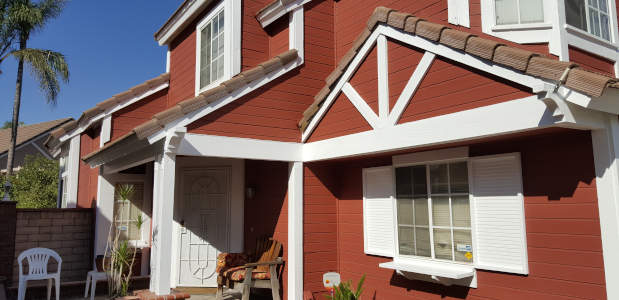
Many homeowners don’t think about house painting until they see their neighbors painting, or worse, find evidence of damage to their siding or stucco. While most homeowners repaint for appearance, it’s important to remember that paint’s primary value is in its function of waterproofing, protecting and preserving your home.
Q: My house is only four years old, but some of my neighbors are already repainting their homes of the same age. Isn’t four years a little early?
A: Although a properly prepared paint job should last about five to seven years, repainting a tract house a few years sooner is usually a good idea to protect your investment. Most production homes are painted with a single coat and there are usually no trees around to help protect them from the sun or wind. Within a couple of years some of the paint may wear away, exposing bare wood.
This is particularly evident on the less expensive T-1-11 vertical siding typically applied to the sides and backs of newer houses. Since the paint on the horizontal siding on the front of houses usually holds up longer, homeowners often don’t notice deterioration occurring sooner around the rest of their home.
Also, production homes are often not sealed with caulking around windows, doors, where the trim meets the siding or stucco, or where trim is butted together. As the house dries out in the summer heat, the wood shrinks and forms gaps, which expand over time to allow rain water into the walls and underhangs. This can also cause drafts and affect your energy bills by allowing heated or cooled air to escape.
Having a professional painter waterproof and paint your house now will fill these gaps and help your wood siding and trim last longer. If you have stucco, painting will preserve its insulating value to keep your house cooler in the summer and warmer in the winter.
Ready to start your House Painting?
Find ProsQ: Would it matter if I put off painting another year?
A: Most homeowners wait too long to repaint their homes, and this procrastination can really cost them money. Investing in a good paint job now, including a complete power wash, thorough caulking, necessary scraping or sanding and well applied quality paint, will protect your home for far less money than it will cost to make repairs a couple years from now.
The most important, timely and labor intensive part of painting a house is the preparation work. The more damage found on the home, the more expensive preparation and repair will be necessary before painting. If the paint is peeling, we have to scrape, sand and apply a primer coat before repainting. If paint has worn off siding or trim, that exposed wood often cracks and twists and needs to be entirely replaced, primed and repainted. If wood has been exposed to water, dryrot develops and spreads to healthy wood. The longer dryrot goes unchecked, the more wood will need to be replaced before painting.
Q: Looking over several homes painted by both licensed and an unlicensed painting contractor, I cannot tell any difference in the quality of the work. Yet the unlicensed painter charges half as much – why not I hire him?
A: All freshly applied paint can look good in the beginning. Licensed contractors are currently competing on a narrow profit margin, so if someone is willing to do it for half price, you need to ask what you are not getting.
About 25 percent of a licensed painting contractor’s price is overhead, including all the taxes, fees and insurances required to be in business legitimately. If you hire an unlicensed contractor for work over $300 and he gets injured while working on your home, you will be responsible to pay for his medical and possible rehabilitation bills.
If an unlicensed contractor just paints in the summer to make extra cash, he probably doesn’t invest in his own quality power washing or painting equipment as full-time licensed painting contractors do. Established contractors have credit accounts with their paint suppliers, but a non-professional may ask you to pay for his materials before he starts working.
If an unlicensed contractor runs into unexpected problems on the job and lacks the experience or ability to solve them, nothing prevents him from walking away from a mess with your money. Even if he intends to be fair, his cheap prices won’t allow for any warranty work months or a year from now, if you can even find him.
Finally, you have to consider a painter’s costs. Since all painters pay about the same for paint, does the lower cost reflect use of thinner or fewer coats or a lower quality or watered-down paint? Most likely, the difference reflects labor costs. If a cheaper job means he won’t do all necessary prep work, the new paint is only as stable as the deteriorating wood or flaking paint it covers. It is only a matter of time until that starts flaking and peeling and looking worse than before you had it repainted. You may have to pay another contractor even more to redo the job next year than you will pay to have it done right the first time.
It is important to consider the true value of the job you will be paying for rather than choosing by price alone. Make sure you walk your property with each contractor who comes to give you a bid, discuss what needs to be done and why, and include everything, including warranties, in the written contract. If a cheaper price means the painter is skipping things like proper preparation before painting, thorough caulking around all windows, care of your landscaping, etc., you are hardly saving money!
Kathy Maynard has been matching homeowners with home improvement contractors since 1990 and has written scores of articles advising homeowners how to find, hire and work with reputable service professionals. She also authors Weekend Warrior, a weekly home improvement column in The Sacramento Bee.
 Creating a Kid’s Fantasy World With Themed Murals
Creating a Kid’s Fantasy World With Themed Murals  Lead Paint Common Sense
Lead Paint Common Sense  Painting Your Home Happy: How Color Choices Affect Your Mood
Painting Your Home Happy: How Color Choices Affect Your Mood  Exterior Painting Techniques
Exterior Painting Techniques  Choosing Exterior Paint Colors
Choosing Exterior Paint Colors 

Are You Familiar With This Topic? Share Your Experience.